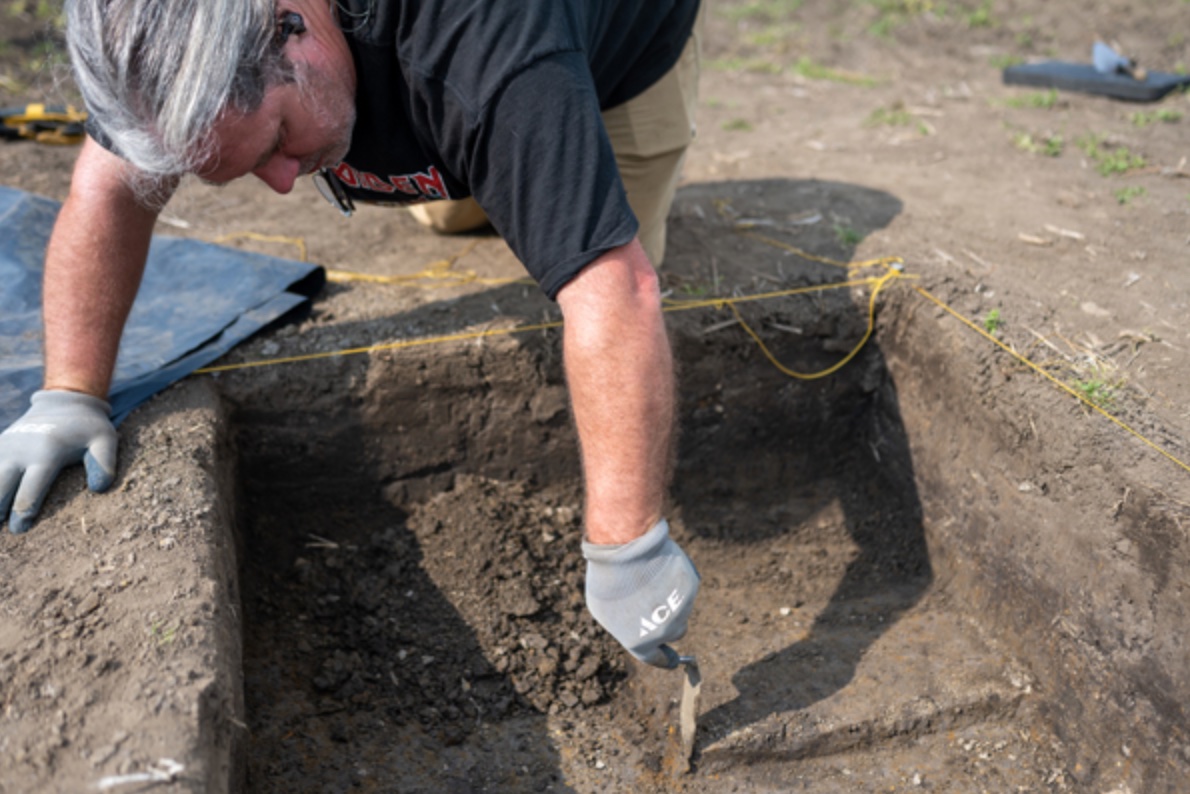
Lancaster Man Makes Rare Archaeological Find
Article Presented By Kingston National Bank…
(Athens, Ohio) – David Lamp has been doing archaeology for 15 years since graduating from Ohio University, helping government and private agencies preserve archaeological and historical cultural resources.
But Lamp was on his hands and knees, trowel in hand, back at OHIO as a graduate student on June 2, when he made the discovery of a lifetime.
The fluted point that he discovered likely dates to some of the first people to live in Ohio — nearly 13,000 years ago toward the end of the Ice Age.
“I have been waiting my entire career to excavate a fluted point from its original resting spot. When my trowel uncovered it, I was stunned. After the adrenaline wore off, I was mentally drained. Most archaeologists never experience this,” Lamp said about his experience in the summer 2023 Field School in Ohio Archeology, run by Joseph Gingerich, associate professor of anthropology in the College of Arts and Sciences.
Lamp explained the importance of this summer’s discoveries, noting, “We have added two intact Paleoindian sites to the archaeological record in a few short weeks. This is a rare thing that may not happen at all during a career in archaeology. In this case, one of those sites, a rockshelter near Lancaster, happens to be extremely rare. There are about 900 Paleoindian sites recorded in the state inventory, but only one or two other fluted points have come from rockshelters.”
In addition to those finds, Ohio University faculty and students uncovered what appears to be an entire ceramic vessel on the Wayne National Forest that awaits further excavation.
“It is not an overstatement to say that you would be hard-pressed to find a student at any university in the nation that has been exposed to what the students of this field school have this year,” Lamp said.
Estimating the age of the Paleoindian occupation
“Ohio is home to some of the oldest known evidence of people in North America,” Gingerich said.
He noted that the first people to navigate Ohio predate the building of the first pyramids of Egypt by 8,000 years. And they arrived in Ohio 8,000 to 10,000 years before the well-known earthen mounds of the Hopewell era were constructed in Ohio.
Lamp earned a B.A. in Anthropology in 2008 from the College of Arts and Sciences and has significant field experience as a cultural resource archaeologist in Ohio, Indiana, Kentucky and Pennsylvania. He’s experienced in historic and prehistoric artifact analysis and curation, with more than 60 cultural resource management reports to his name, and has taken part in hundreds of archaeological projects throughout his career. Now Lamp is back at college in his second year of graduate school, pursuing an M.S. in Environmental Science through OHIO’s Voinovich School of Leadership and Public Service. Lamp’s summer plans also include an internship with the Wayne National Forest.
“I waited a long time for graduate school, mostly because the time was never right to do research in an area that truly interested me. I feel fortunate to be a part of this program with Dr. Gingerich as my committee chair, and to make a career-defining find a mile from my home. More importantly, I am thrilled to make a contribution to knowledge in the discipline that I love,” added Lamp, who lives in Lancaster.
Lamp explained that dating the fluted point is done by comparing this point to others that have been carbon-dated and are of a known age.
“The style of these points was generally very consistent and the presence of the flutes, along with other characteristics, can allow for a relatively accurate estimate of age,” Lamp said. “The pottery (found at the site) also helps date the later components of the site because the physical characteristics of the pieces, including thickness, decoration, etc., can be used to date the pieces.”
A fluted point is a spear point that has been thinned at the base to create a groove or channel, which may have been created for hafting it to a shaft.
Ohio’s True Pioneers: Prehistoric Native Americans
Gingerich oversees both the fieldwork and laboratory analysis of the Field School in Ohio Archaeology, which began in 1986 by Dr. Elliot Abrams, professor emeritus of anthropology. The program since has excavated several dozen archaeological sites, trained more than 400 undergraduate students in archaeological methods and preservation, and made significant contributions to anthropologists’ understanding of the prehistoric past.
Gingerich recently authored the first chapter in a new book, “Settling Ohio: First Peoples and Beyond,” where he discusses prehistoric Native Americans in Ohio.
“When Americans think of ‘pioneers,’ they think of people in historic contexts: settlers, inventors and explorers who reached new frontiers in science or geographic exploration. They seldom think of the very first people in North America, those who were the first to explore, farm, establish settlements, and create monumental architecture,” Gingerich writes. “These first people were not the brave men and women that David McCullough talks about in his New York Times bestseller…. The true pioneers were those American Indian populations that first saw and explored the North and South American continents. Their story begins more than 13,000 years ago.”
Gingerich also notes that Ohio is “one of only nine independent domestication events (the adaptation of wild plants and animals for human use) in the world, and the center of one of the largest feats of monumental architecture (the Hopewell Ceremonial Earthworks) ever created.”
‘Evidence of habitation occurred in the first soil we processed’
Gingerich and Lamp began working together in 2021, before Lamp began graduate school, at sites here in Ohio, as well as along the Roanoke River in Virginia.
An experienced excavator, Lamp approached the site methodically.
“The rockshelter in Lancaster looked like many that I have excavated and was in no way exceptional. It is somewhat small as rockshelters go. That said, it has a southern orientation and has a somewhat dramatic appearance as you approach, in spite of its small size,” he noted. “The grid was established by first setting up a datum, which is a fixed, permanent reference point that will allow us or other researchers to return and find that exact locations of the test units that we excavated and the positions we recorded.”
Once all the students got to work in their grid squares, it didn’t take long for the discoveries to begin.
“Evidence of habitation occurred in the first soil that we processed,” Lamp said.
So far this summer, the students have recovered “all of the things that you would typically expect in a rockshelter site,” he said, including parts of stone tools, manufacturing debris from those tools, animal bone, bivalve shells, pottery from Woodland Period peoples, as well as the Paleoindian finds.




























